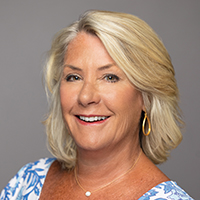Moderator:
Kymber Lovett-Menkiti, President, Keller Williams Capital Properties, Washington D.C., Broker Relations Liaison, National Association of REALTORS® (NAR)
Panelists:
Cindy Ariosa, Senior Vice President, Regional Manager, Long & Foster Real Estate, Baltimore
Joan Docktor, President, Berkshire Hathaway HomeServices Fox & Roach, REALTORS®, Philadelphia
Tommy Flood, Regional Director, Keller Williams, North Texas, New Mexico, Memphis, Tenn.
Scott MacDonald, President, RE/MAX Gateway Real Estate, Chantilly, Virginia
 Kymber Menkiti: In much the same way Uber upended transportation as we knew it, iBuying, or instant offers and buying, has been an undercurrent in the real estate world for the better part of the last 10 years. Major players, some more successful than others, have spent big dollars to attract sellers who, for one reason or another, opt to skip the traditional selling process in favor of an instant cash sale—Brokers have also launched their own programs or created partnerships to compete with strictly tech-driven companies. Is iBuying a viable strategy in today’s slowing market where, in spite of tight inventory in much of the nation, homes are no longer flying off the shelf as they were just a few months ago?
Kymber Menkiti: In much the same way Uber upended transportation as we knew it, iBuying, or instant offers and buying, has been an undercurrent in the real estate world for the better part of the last 10 years. Major players, some more successful than others, have spent big dollars to attract sellers who, for one reason or another, opt to skip the traditional selling process in favor of an instant cash sale—Brokers have also launched their own programs or created partnerships to compete with strictly tech-driven companies. Is iBuying a viable strategy in today’s slowing market where, in spite of tight inventory in much of the nation, homes are no longer flying off the shelf as they were just a few months ago?
 Cindy Ariosa: iBuying is not an altogether new strategy. We used to call it a “guaranteed sales program.” But margins can be so tight for profitability with today’s tech-driven buys that unless you are operating in a cookie-cutter community, where the houses are pretty much identical, the margin for error in determining the exact value is pretty high. If you make a couple of miscalculations, the loss can be significant—maybe in the hundreds of thousands on just a few homes. Some of these major players bought hundreds of homes. It’s no wonder they’ve stopped making offers.
Cindy Ariosa: iBuying is not an altogether new strategy. We used to call it a “guaranteed sales program.” But margins can be so tight for profitability with today’s tech-driven buys that unless you are operating in a cookie-cutter community, where the houses are pretty much identical, the margin for error in determining the exact value is pretty high. If you make a couple of miscalculations, the loss can be significant—maybe in the hundreds of thousands on just a few homes. Some of these major players bought hundreds of homes. It’s no wonder they’ve stopped making offers.
 Joan Docktor: Margins are shrinking as home prices drop—and in our market, where homes are mostly older and quite dissimilar, you can’t use that cookie-cutter approach to valuation. Even though homes are on market a bit longer right now, the iBuyer strategy has never gained a foothold where we are because it’s still basically a seller’s market. That said, there will always be flippers, even among the market’s individual agents.
Joan Docktor: Margins are shrinking as home prices drop—and in our market, where homes are mostly older and quite dissimilar, you can’t use that cookie-cutter approach to valuation. Even though homes are on market a bit longer right now, the iBuyer strategy has never gained a foothold where we are because it’s still basically a seller’s market. That said, there will always be flippers, even among the market’s individual agents.
 Tommy Flood: In our 14-market region, iBuying has been a rallying cry for more than two years. A lot of sellers love the convenience—and done properly, it’s a great tool for agents to have. We partner with an aggregator called iFinder, offering the same property to more than 100 investors. Some of them are agents looking to build their investment portfolio, and others are institutional investors. Because there’s competition, some 65% of transactions come in at or over the selling price.
Tommy Flood: In our 14-market region, iBuying has been a rallying cry for more than two years. A lot of sellers love the convenience—and done properly, it’s a great tool for agents to have. We partner with an aggregator called iFinder, offering the same property to more than 100 investors. Some of them are agents looking to build their investment portfolio, and others are institutional investors. Because there’s competition, some 65% of transactions come in at or over the selling price.
 Scott MacDonald: While iBuying is not for all sellers, there are enough to make it a viable solution for many—and the concept can be a great lead generator for agents. ZinCasa, the company I co-founded with Brian Wildermuth, provides a turnkey iBuyer solution that not only helps our agents compete but puts them squarely in the middle of the transaction.
Scott MacDonald: While iBuying is not for all sellers, there are enough to make it a viable solution for many—and the concept can be a great lead generator for agents. ZinCasa, the company I co-founded with Brian Wildermuth, provides a turnkey iBuyer solution that not only helps our agents compete but puts them squarely in the middle of the transaction.
KM: Consumers are always best served when agents are involved—especially now, in a slowing market.
TF: Sellers are bombarded with iBuyer information anyway. Why shouldn’t our agents be ready to compete with an option that makes total sense?
JD: That’s true, so long as we continue to look out for our sellers and their properties are not heavily discounted.
CA: Today’s market is such that buyers are being more creative—asking sellers to do a buy down on their loans, for example—and most iBuyer homes are not set up to handle “creative financing.” We’re not seeing as many multiple offers as we did last summer, except on the most desirable properties—and buyers need their cash to get the house, not necessarily to fix it up.
TF: There are programs that offer the seller cash up front for fix-ups. We have such an offering, designed to help sellers whose homes need a bit of a rehab to be competitive.
SM: Our objective is to help agents walk into a listing with a full range of options for every seller, from traditional sales strategies where they are most appropriate to the all-cash instant buy if that works best. No showings, no repairs, no one traipsing through their home, no hassle for sellers who don’t want them but do want to see best price offers.
JD: But it varies from market to market. We’ve not seen the need for an iBuyer strategy yet, but that doesn’t mean we are not keeping our options open.
SM: What we need to bear in mind in any market—and in every environment—is that nothing can replace the human element. Brokers have an obligation to keep their agents front and center.
KM: So, the bottom line is that the brokerage should be looking for every opportunity—and every possible resource for their agents.
For more information, visit https://www.nar.realtor/.












